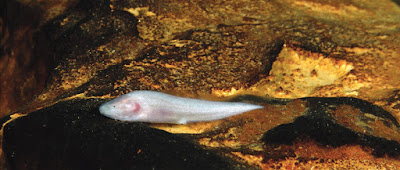 |
| Lucifuga gibarensis
Hernández, Møller, Casane & García-Machado, 2020
|
Abstract
Recently, a barcoding study and a molecular phylogenetic analysis of the Cuban species of the cave-fish genus Lucifuga Poey, 1858 revealed the existence of different evolutionary lineages that were previously unknown or passed unnoticed by morphological scrutiny (i.e., cryptic candidate species). In the present study, Lucifuga gibarensis is described as a new species restricted to anchialine caves in the northeastern karst region of the main island. The species was earlier described as a variety of Lucifuga dentata, but since the name was introduced as a variety after 1960, it is deemed to be infrasubspecific and unavailable according to the International Code of Zoological Nomenclature Art. 15.2. The new species differs from L. dentata by pigmented eyes vs. eyes absent and lack of palatine teeth vs. present. Lucifuga gibarensis seems to be most similar to the Bahamian species L. lucayana by showing pigmented eyes, 13 or 14 precaudal vertebrae and ten caudal fin rays. However, differs from it by a larger size of the pigmented eye (1.1–1.9 vs. 0.9–1.0% SL) and number of posterior lateral line neuromasts (30–33 vs. 34–35).
Keywords: Anchialine caves, Gibara, Holguin, speleology, taxonomy, viviparous brotulas
Taxomomy
Family Bythitidae
Genus Lucifuga Poey, 1858
Type species: Lucifuga subterranea Poey, 1858 by subsequent designation of Jordan and Evermann, 1896, type locality: El Cajio cave, but not precisely stated for L. subterranea, which was referred originally from caves of San Antonio, middle-south Havana province, Cuba.
Diagnosis:
Body moderately elongated and compressed mainly from the abdomen to the caudal end. Snout with two nostrils: anterior nostril tube-shape and smaller, placed near to the upper lip; posterior nostril is a larger hole, placed ca. midway between snout and eyes cavity. The mouth is subterminal with the lower jaw only slightly shorter than the upper. Opercular spines absent. Seven branchiostegal rays.
The entire body is covered with small, rounded cycloid scales; fins naked except for scales on pectoral fin basis. Predorsal area and operculum scaled. Branchiostegal membranes, entire underside of the head, snout, interorbital areas and entire course of the cavernous cephalic system are naked. Origin of dorsal fin approximately above the tip of pectoral fins. Pelvic fin is subjugular with a single ray reaching ca. 1/3 to halfway to the anus. Pectoral fin behind the operculum, peduncle short and narrow. Lateral line with two series of sensory neuromasts: upper and anterior series extends from the head to a point ca. midway between dorsal and anal fin origins; and lower and posterior series extends from a point under and slightly in advance of the end of the upper series to the mid side from the caudal base.
...
Lucifuga gibarensis sp. nov.
Common name: Gibara cave brotula (English)
Lucifuga dentatus variety holguinensis Díaz-Pérez et al., 1987b: 44.
Lucifuga dentatus var. holguinensis Hernández 2005: 15; García-Machado et al. 2011: 471.
Lucifuga holguinensis Proudlove 2019.
Diagnosis: Dorsal fin rays 72–90; anal fin rays 58–72; pectoral fin rays 15–17, caudal fin rays 10; palatine teeth absent; rakers on anterior gill arch 17–19 (long gill-rakers 3); occiput and area between lateral canal and preopercular canal scaled; diameter of pigmented eyes 1.1–1.9% SL; total vertebrae 50–53.
Etymology: The specific epithet refers to the village of Gibara, where the three caves inhabited by this species are located. We do not follow variety epithet used by Díaz-Pérez et al. (1987b), since the L. gibarensis better describes the narrow distribution of the species near the village Gibara instead of the entire region Holguin.
Damir Hernández, Peter Rask Møller, Didier Casane and Erik García-Machado. 2020. A New Species of the Cave-fish Genus Lucifuga (Ophidiiformes, Bythitidae), from eastern Cuba. ZooKeys. 946: 17-35. DOI: 10.3897/zookeys.946.51373


